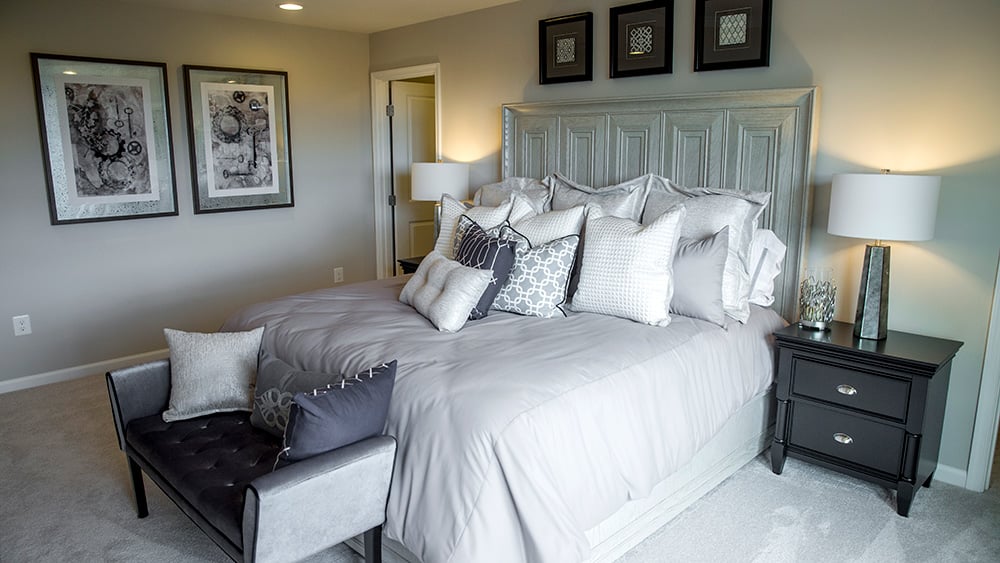Waking up in a comfortable bedroom can set the tone for your whole day. If your room has an atmosphere that leaves you feeling refreshed and relaxed, it can have a major impact on your daily life and help you get the sleep your body needs.
But bedrooms are about more than just sleeping. Your bedroom should be a place where you can go to get away, unwind, and feel 100 percent comfortable all of the time.
The bedrooms in the homes at Brunswick Crossing already have an elegant design and luxurious feel that give residents a welcoming place to live and sleep. But if you’re looking for a way to make your bedroom even cozier, follow these 10 helpful tips:
1. Adjust Lighting
Simply adjusting the way your bedroom is lit can make a huge difference in your room’s overall comfort level. Making soft light choices as opposed to bright, harsh overhead lights is a good way to go. In fact, avoiding overhead lighting if possible is one way to make the light in your room cozier. The use of dimmers on your bedroom’s lights can give you ultimate control over brightness levels and using lampshades on bulbs helps disperse light throughout the room. To prevent your room from being too bright from natural sunlight, install room-darkening blinds, shades, or drapes.
2. Layer Rugs
It doesn’t matter if your bedroom is carpeted or you have hardwood floors, having throw rugs are an excellent way to add texture and color to your bedroom. This, of course, can also make for warmer, cozier surfaces to walk on. Layering rugs together in different shapes and patterns is an easy way to add some comfort to your bedroom.
3. Add More Pillows
Piling on the pillows in your bedroom is another way to create a comfortable atmosphere. After all, what could be comfier than a pile of fluffy pillows? When it comes to pillows and their role in bedroom comfort, typically the more the merrier. You can also mix and match different pillow colors and designs to add to the decor of the room.
4. Strategically Place Furniture
The placement of your bedroom furniture can make a huge difference in comfort. Be sure to not clutter your bedroom too much, as this can lead to a stressful, unorganized environment. The location of the furniture in your bedroom should be practical, functional, and welcoming. Examples of an optimized bedroom floor plan include facing your bed away from doors and windows, keeping nightstands within reach of your bed and make sure they’re the right height, as well as delegating different areas of the room for certain activities (i.e. a reading nook, a work station, sleeping space, etc.)
5. Get Good Bedding
Investing in good bedding is a great decision for improving a bedroom’s comfort. This is perhaps the most important aspect of a bedroom to spend your money on because it will directly affect the quality of sleep you get. Choose high-quality, soft fabrics for your bedding materials—on top of making sure you choose a mattress that’s right for you—and you won’t regret it.
6. Hide Electronics
Electronics very rarely add to the comfort level or welcoming atmosphere of a bedroom. Sure, watching your favorite show from your cozy bed is comfortable, but the visible electronics cords are not. Hide electronics when possible and try to identify which ones are giving off noises or light that could affect your sleep.
7. Display Inspiring/Calming Artwork
Hanging artwork or displaying decor in your bedroom that is inspiring and calming will help create the relaxing tone you’re searching for. Scenic artwork of natural settings can be great choices, as can significant photographs or historical memorabilia that tell a little bit about your personality.
8. Reduce Noise
Reducing noise in your bedroom will lead to better sleep. Gadgets and electronics that give off sound can keep you awake at night. Try either parking these devices as far away from your bed as you can or putting them on silent each night. Sometimes adding white noise to your bedroom with a fan or air purifier can be an effective strategy, as well.
9. Control Temperature
A room that is too hot or too cold can’t possibly be comfortable, but there are things you can do to control the temperature in your bedroom. An ideal temperature for sleeping is about 65 degrees. Consider programming your thermostat to that temperature. While we mentioned earlier that you can never have enough pillows, adding too many could cause a temperature increase in your bed and make sleeping uncomfortable. If you want the pillows on display during the day, perhaps remove some of them at night when it’s time for bed.
10. Give Thought to Colors
Certain color schemes and hues can add or detract from the comfort level of a bedroom. While there’s no clear-cut answer between whether dark hues or bright colors work better for a comfier room, it’s important to figure out what is more inviting to you and what will help you feel most relaxed and comfortable. Some believe an all-white room makes for the coziest space, while others prefer a dark color that envelops a room more. Whichever you choose, aim for consistency and pair your bedroom’s color with decor and materials that complement the comfort.
Excited to remodel your bedroom for better comfort yet? Why not start fresh by choosing from one of the many great models at Brunswick Crossing that have anywhere from 3-5 versatile and elegant bedrooms. Learn more about our models by clicking below.




